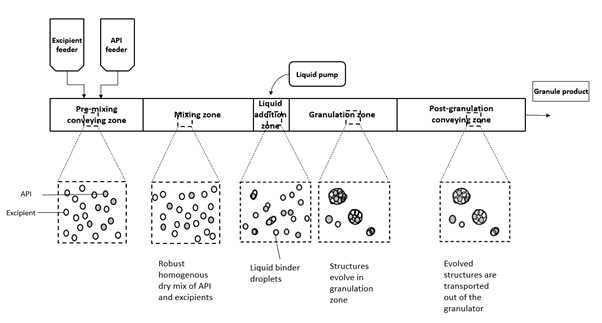Wet granulation is a size enlargement process in which fine powders are agglomerated in the presence of liquid to form granules with controlled properties [1]. Wet granulation enhances the flow properties of the powder mix, prevents segregation, prevents caking of powders during downstream processing and storage, and alleviates the problem of dusting downstream [2]. Wet granulation is generally preferred over roller compaction if the formulation is either poorly flowing or if the formulation has poor tabletability, or if weak cohesive forces exist among powders or if the powders stick on the rolls or if multiple of these factors are present in the formulation [3]. Some of the properties that are controlled during this process are particle size distribution, component content uniformity, porosity, etc. [4].
Among various types and modes of granulation processes, twin-screw granulation (TSG) is a popular continuous wet granulation technique [4-6]. The twin screw wet granulator (TSG) consists of two parallel co-rotating screws housed within a chamber. Some of the major advantages of twin-screw granulation are decreased production times, flexible production rates, flexible formulation development, enhanced product quality, and the possibility of improved process control due to the enablement of real-time product assessment [7].
The physics behind twin-screw granulation is significantly different compared to batch granulation techniques [2]. The major difference is that a high amount of shear is applied for a very short time to produce robust granules. The typical granulation time in twin-screw granulation is in the order of seconds. Achieving robustness in granule quality in such a short time would require intense homogenous mixing inside TSG [8]. In the recent years, studies have focused on understanding the implications of mixing in a twin-screw granulator. Some of these studies have analyzed the effect of twin-screw granulator parameters on blending/dry mixing alone [9]. While other studies focused on understanding the effect of different twin screw parameters on mixing during wet granulation and ultimately the effect on granule critical quality attributes [8, 10, 11]. These studies have shown that robust mixing or robust granulation can be achieved in a twin-screw granulator by optimizing the screw and process parameters.
These studies have inadvertently shown that only a fraction of the volume of the TSG is required to achieve robust granules/mixtures. This gives rise to an opportunity to design a process with blending and wet granulation being performed sequentially within the same twin-screw granulator. Some of the major potential benefits of such a design are process intensification due to the elimination of a dedicated blending step, reduction in segregation potential of the blends due to circumvention of additional material transport, and improved containment of powders.
The current study is an attempt to leverage this benefit and design a process with blending and wet granulation being performed sequentially within the same twin-screw granulator (Figure 1). The present study was divided into two aims, where the first aim was to understand and optimize the screw parameters and process parameters to obtain robust mixing. Following this, the second aim leveraged the screw design of the first aim to understand the effect of the second kneading zone and process parameters on the quality attributes of the granules. As a part of this study, the authors analyzed the effect of kneading elements, stagger angle between kneading elements, screw speed and feed rate on blending and granulation in TSG. By following this approach, the authors were able to successfully design a twin-screw granulation process to perform blending and granulation sequentially. Moreover, the output of this process resulted in robust granules, which were tested for particle size distribution, content uniformity, and tablet compactability.


